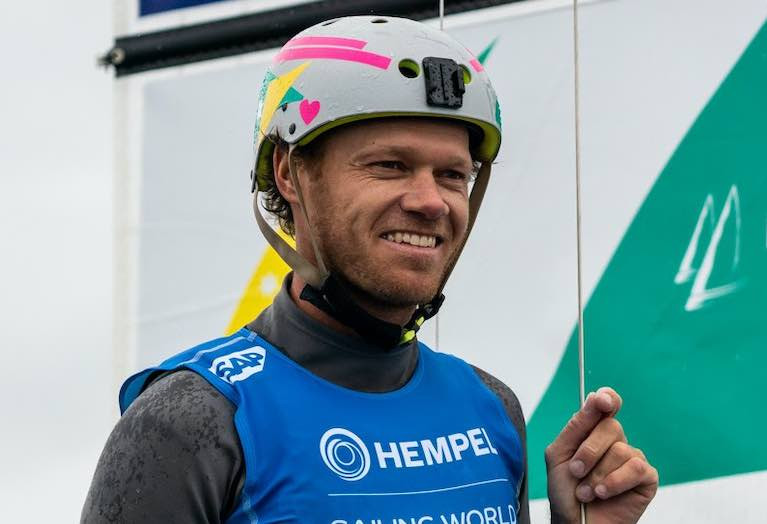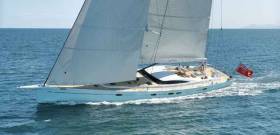Displaying items by tag: Marcus Spillane
Marcus Spillane is International "Sailor of the Month" for November
The election of Marcus Spillane – originally of Cork – to a Vice Presidency of World Sailing in November is the latest step in an extraordinary involvement in sailing which has seen him compete in many world championships – most notably in the International 49er – while at the same time playing key roles in global sailing administration.
He did much of the heavy lifting in making the Olympic International 49er Association the force it is today, serving as Class CEO for six years and then being President for eight. These were tasks he performed with such efficiency that when the Olympic NACRA 17 class came into being, he was persuaded to take on its Presidency for its first four formative years, while though now US-based, he maintained his close links with Ireland through being Treasurer to Irish Sailing's Olympic Steering Group. At a difficult time in its own development, World Sailing has recruited the administrative abilities of exceptional talent with a highly proven track record.
 In the thick of it – Marcus Spillane and Rory Fitzpatrick racing a 49er in the Worlds
In the thick of it – Marcus Spillane and Rory Fitzpatrick racing a 49er in the Worlds
Cork's Marcus Spillane Resigns as NACRA 17 President & is Replaced By Australian Gold Medalist
Olympic Gold medalist Nathan Outteridge of Australia becomes the interim president of the International Nacra 17 Class Association, taking over from Ireland's Marcus Spillane from Cork Harbour.
Spillane was recently elected as Vice President of World Sailing, and, according to the NACRA 17 class, to avoid any 'real or perceived conflicts of interest' Spillane resigned as president of the Nacra 17 Class effective November 1, 2020.
Nathan is one of the most celebrated sailors of all time, as a multiple youth World Champion, 49er Class Gold and Silver medalist, Moth Class World champion, America’s Cup helmsman, and current helmsman of SailGP Team Japan. Nathan also campaigned for the Tokyo Olympics in the Nacra 17, twice finishing second at the World Championships but was not selected to the Tokyo Olympic team by Australia.
“The biggest challenge of the Nacra 17 class has been that every critical decision of the class has been almost 50-50 in terms of opinion,” said Spillane. “With such a large and diverse fleet, deep in every continent, broad in age ranges, and of course mixed in gender, there are no shortages of opinions and many varying backgrounds and perspective in the fleet. It has been a wonderful challenge to be a part of stabilizing and improving the class. While I must step down as president of the class earlier than I had planned for, I do so knowing that Nathan is more than able for the role.
The Nacra 17 class and sailors have issued a thank you to Spillane for his time as President and wish him continued success in his new leadership role with World Sailing.
Cork's Marcus Spillane Elected as World Sailing Vice President
Marcus Spillane, Ireland's candidate for one of seven new vice president roles in World Sailing has been successful in his election bid it was announced today at World Sailing’s Virtual General Assembly.
Quanhai Li (CHN) has been elected as World Sailing President. In a closely contested election Li will lead the organisation for the next four years.
At the same election, Ireland's Spillane was elected to serve as one of seven World Sailing Vice- Presidents.
Li was originally elected a vice- president in 2012 and is a former Secretary-General of the Chinese Yachting Association. He played a large role in the planning and execution of the sailing event at the 2008 Olympics and has been an International Judge.
Spillane, originally from Cork but now USA-based, becomes the first Irish Vice-President since Dubliner Ken Ryan who held the role from 1998-2004.
Spillane, a chartered accountant, is the Treasurer of the Olympic Steering Group of the Irish Sailing Association.
Spillane sailed Mirrors and Laser 2s as a junior sailor before graduating to the 49er. More recently he has competed offshore in various events. Administratively he has served as International class president of the Laser 2, 49er and Nacra 17 classes. He has been Ireland's nominee to the World Sailing Council since 2016.
Spillane was sixth of the seven successful candidates. The new eight-person Board (President and 7 VPs) has a five to three male to female gender balance, with four Europeans and one each from Asia, Australia, South Africa and North America.
Four Presidential candidates were up for election in the first round and no candidate received more than 50% of votes. A second round of voting was required between the top two candidates. Kim Andersen (DEN) and Li advanced to the second round.
 Quanhai Li (CHN) has been elected as World Sailing President
Quanhai Li (CHN) has been elected as World Sailing President
In the second round of voting, 128 Member National Authorities, in good standing with World Sailing, sent verified votes to the Independent Scrutineer. Receiving 68 votes, Quanhai Li was elected as World Sailing President. Andersen received 60 votes.
World Sailing Member National Authorities, in good standing with World Sailing, were eligible to vote and when casting their ballot, they were required to vote for at least two male and two female candidates for Vice President.
Li upstaged the incumbent, Kim Andersen (DEN) in a run off-vote following the elimination of two of the four candidates. The transfers proved crucial, as Li gained 29 of the 36 available votes to win by 68 votes to 60. It is believed that holding the conference virtually, allowing for many more than normal MNAs to vote, favoured Li whose campaign addressed those MNAs who traditionally did not attend AGMs. The electorate of 128, easily exceeded the previous record of the 106 delegates who attended (in person) the 2012 election in Dun Laoghaire.
The election process for Vice-Presidential candidates concluded on 16 October with no run-off voting process required. MNAs were invited to vote for seven Vice-Presidents, of which at least two votes for male and two votes for female candidates were required.
Joining World Sailing President Quanhai Li on the Board of Directors will be:
- Tomasz Chamera (POL)
- Sarah Kenny (AUS)
- Philip Baum (RSA)
- Yann Rocherieux (FRA)
- Duriye Özlem Akdurak (TUR)
- Marcus Spillane (IRL)
- Cory Sertl (USA)
There is a serious work programme ahead. In addition to the problems caused by the pandemic, World Sailing's finances are precarious and new CEO David Graham confirmed a hiring and salary freeze until stability has been achieved.
While the conference was run successfully on-line, it was understood that the combination of time zone differences, the lack of face-to-face meetings on the fringes and the technical lapses in internet connections will result in a hybrid of physically present and virtual meetings in future.
David Graham, World Sailing CEO, commented, “I warmly welcome Mr Quanhai Li as President of World Sailing; it is a great advantage having already served for eight years on the Board. Our new President is joined by a very strong set of Vice-Presidents who have a wealth of experience as former Council and Committee members. The future of World Sailing is in very capable hands and I look forward to working with our new Board. World Sailing’s elected Board work incredibly hard and I take this opportunity to thank the outgoing members for their huge efforts over their term.”
The Chairman of the Athletes' Commission will join the Board of Directors as a permanent voting member. In addition, the World Sailing Presidents of Honour, His Majesty King Harald V of Norway and His Majesty King Constantine are entitled to attend and participate in Board of Directors meetings, but they do not hold a vote.
The newly appointed Board of Directors will serve a four-year term up until the 2024 General Assembly.
World Sailing's 2020 Election of Officers was overseen by an Election Committee, chaired by Philip Cotton and supported by Melanie Willmore and David Kellett. KPMG (UK) LLP were appointed as the Independent Scrutineer and accepted and validated the votes on behalf of World Sailing.
Irish Candidate Marcus Spillane Waits for World Sailing Election Result
Marcus Spillane, Ireland's candidate for Vice President of World Sailing, will have to wait another couple of weeks to find out if he has been successful in his bid for office in the world governing body of the sport even though the votes are cast and the Election Committee has declared a result has been obtained and no further rounds of voting are necessary.
It is expected the results will be notified to the General Assembly during its meeting on Sunday 1 November.
As Afloat reported previously, US-based Spillane, a chartered accountant, is the Treasurer of the Olympic Steering Group of the Irish Sailing Association. He is also the president of the Nacra class and, in that capacity, announced today that the Olympic skiffs and the Olympic Cats will be hosted by The Sultanate of Oman for its 2021 World Championships.
World Sailing Presidential Election
127 Member National Authorities submitted a verified vote to the Independent Scrutineer by the deadline on Friday 16 October. The ballot papers were sent to the Election Committee by secure means on Friday evening with all identifying information removed.
The members of the Election Committee have now counted and verified the votes and agree the results.
No discrepancies or irregularities in the votes have been reported by the Independent Scrutineer or by the members of the Committee.
As required by Regulation 4.2, a candidate for President must obtain more than 50% of the votes in order to be elected. If no candidate receives more than 50% of the votes, then a runoff vote must be held between the top two candidates.
No candidate has received more than 50% of the votes. A second round of voting will therefore be required.
The second round will be between:
ANDERSEN, Kim (DEN)
QUANHAI, Li (CHN)
Voting packs will be sent to MNA Officers on the morning of Tuesday 20 October 2020. Voting will open when the packs are distributed and will close at 1500hrs UTC on Friday 23 October 2020.
The number of votes received by each candidate will be published following the declaration of the results at the General Assembly.
Irish Sailors Still Well Up in RORC Caribbean 600 Mix
Maybe it’s because the weather has been unseasonably like home at times out in the Caribbean, but the Irish sailors spread through the RORC fleet have been in the racing frame through a wet cold front from the nor’west. For a while, it turned sunshine hopes upside down, but the Micks in the mix are on boats which have been showing mighty well since last’s night’s posting, when top navigator Ian Moore on Bella Mente was leading the fleet on IRC writes W M Nixon.
The first of the multi-hulls, Lloyd Thornburg’s MOD 70 Phaedo 3 with Damian Foxall on the strength, has already taken line honours in 33 hours. But further down the line, the pendulum of fortune has swung back and forth as monohull boats of hugely varying sizes take on the challenges of a real cat’s cradle of a course.
The vagaries of fortune are revealed by the fact that for some hours this morning Irish time, the overall leader was the superyacht Dannesskjold, whose crew include Tim Goodbody, Aine Hanevy, and Paul O’Donoghue, while the Kinsale-registered Lilla was third. But the most recent set of figures show that Dannesskjold has plunged to 32nd overall, while Lilla plunhed to 48th, and the best-placed Irish sailor is now Marcus Spillane, originally of Cork, now San Francisco-based, an ISA Board Member and representative on World Sailing.
He also presides over the 49er International Association and the Nacra 17 Association, but currently his focus is on getting the best performance out of the Swan 66 Bounty in the Caribbean 600, and they lie third overall, 20 minutes or so ahead of George David’s Rambler 88 in fourth, and 45 minutes ahead of Bella Mente in 5th. Yet while Phaedo may be well finished, but there’ll be many twists of failure and fortune before we get the final IRC placings.

































































